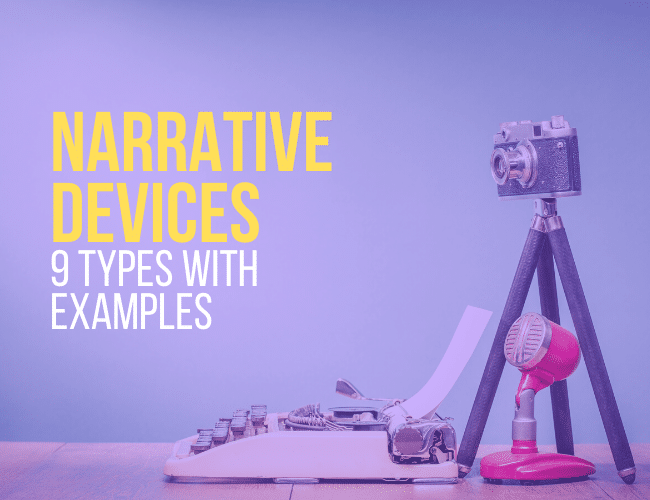How do you tell a story? Not how do you construct a story, or how do you structure and plot a story. How do you actually tell a story?
When I think about storytelling at its most basic, I think about our earliest ancestors, sitting around a campfire, sharing stories about their lives, the adventures they’ve been part of, and the history of their people.
Narrative devices are about how you tell the story, and if you’re a writer, the method and perspective of your storytelling is something you must consider.
In this article, we’re going to talk about narrative devices, what they are, the different types found in the best books, plays, films, and serials, and how to use them to tell a powerful story.

First, let’s start by defining what a narrative device is.
Narrative Devices: Definition
Narrative devices, also known as narrative framing devices, are the method (or narrative techniques) by which a story is narrated. These narrative devices involve who is narrating the story and how they’re narrating it. The narrative device becomes the guidepost by which you tell your entire story.
If that sounds abstract, you're right! To really understand narrative devices, it’s best to learn from example. Skip ahead to the list of narrative devices below.
Narrative Devices Can Help You Win Literary Awards
Before we get into the examples, let me say this: if you’re interested in experimental writing, the cutting edge in fiction and the kind of work that can win you literary awards, narrative device has consistently been the literary technique in which to play—more so than nearly any other literary device.
Examples of award-winning writers who have creatively used narrative technique to win them fame and fortune include Stephen Chbosky, Joseph Conrad, Margaret Atwood, William Shakespeare, and even Geoffery Chaucer.
List of Narrative Devices
Here's a quick list of the narrative devices:
- Chronological Narrative
- Reverse Chronological Narrative
- Real Time Narrative
- Breaking the Fourth Wall
- Epistolic or Diary
- Documentary or Mockumentary
- Story Within a Story, also known as a Framing Story
- Story Within a Story Within a Story, also known as a Framing Story Within a Framing Story
- Stream of Consciousness
Now, let's get into the nine devices.
The 9 Narrative Devices
How will you tell your story? Find the list of narrative techniques below:
1. Chronological Narrative
In a chronological narrative, the events follow chronological and sequential time order. Flashbacks, memories, and dreams may also be used to give information and show events to the reader at the right moment, but the narrative soon returns to a chronological order of events.
Chronological narrative is by far the most common narrative device, to the extent that it is the default of ninety-nine percent of novels, films, and memoirs.
2. Reverse Chronological Narrative
Reverse chronological narrative, the opposite of chronological narrative, is when the scenes follow the reverse of chronological order. That is, the story starts at the end and goes backwards, telling the story in reverse order.
Unlike chronological narrative, the reverse is not a common device. The primary example is the Christopher Nolan film Memento, which was hailed as one of the most important films of the early 21st century.
3. Real Time Narrative
Real time narrative is a version of chronological narrative in which each hour of the narrative corresponds to one hour of events within the story. This narrative device is only available to film (or theater). The primary example of this device is the television series 24.
4. Breaking the Fourth Wall
The narrator or specific characters (rarely all characters) can address the reader or viewer directly, sometimes referring to them as “dear reader.”
The origin of this device is theater, the fourth wall referring to an imaginary wall between the audience and the actors. By “breaking” the fourth wall, the actors speak directly to the audience.
While first found in theater, this device is also used in other forms, including novels, memoir, and film.
Examples of this device include How to Train Your Dragon by Cressida Cowell (a novel before it was a film trilogy!), Woody Allen’s Annie Hall, William Goldman’s The Princess Bride (also a novel before it was a film), Puck’s final monologue in Shakespeare’s A Midsummer Night’s Dream, Cervantes’ Don Quixote, and even Chaucer’s Canterbury Tales.
In my own writing, I used this device in my memoir Crowdsourcing Paris. Personally, I find addressing the reader directly lends a sense of intimacy and authenticity to the narrative.
This device may be combined or even enhanced by other narrative or literary devices.
5. Epistolic or Diary
Taking the idea of breaking the fourth wall further, the epistolic narrative device (epistolic, as in a letter) or diary narrative device allows the narrator to address the reader directly through a letter or diary format. This is one of the most popular narrative devices in literature, and it has been used in stories ranging from Gillian Flynn’s Gone Girl to Mary Shelley’s Frankenstein to Stephen Chbosky’s Perks of Being a Wallflower to Salman Rushdie’s Midnight’s Children.
Another version of this is an oral history narrative device, in which an oral telling of the story replaces the letter or diary. William Faulkner notably used this method in Absalom, Absalom and The Sound and the Fury. Joseph Conrad also used it in Heart of Darkness, in which a seaman returning home from a voyage relates a story to his crew mates of an adventure gone wrong.
6. Documentary or Mockumentary
Originating in the reality TV format, the mockumentary narrative device assumes that there is a documentary crew following the characters as they go through the events of their (fictional) lives. This allows characters within the narrative to address the viewer directly through interspersed interviews and occasional moments where the characters look directly into the camera.
The Office is a good example of this device, as well as Waiting for Guffman and This Is Spinal Tap.
Like the epistolic narrative device but for film, this allows the characters to share their inner monologue directly with the audience during the events of the story, something that was not previously possible in film.
Later iterations of this style have removed the conceit of the documentary crew altogether, even as they keep the interviews, like later seasons of The Office and the show Modern Family.
7. Story Within a Story, also known as a Framing Story
A framing story is a narrative device in which there is another story within the story that is somehow related. This is device has been used by some of the best writers in history. William Shakespeare was especially fond of this storytelling method, and included it in several of his plays, including Hamlet, A Midsummer Night’s Dream, and Taming of the Shrew, among others.
8. Story Within a Story Within a Story, also known as a Framing Story Within a Framing Story
Taking the framing story a step further, Margaret Atwood’s Blind Assassin uses a story within a story within a story to further layer her plot.
9. Stream of Consciousness
Stream of consciousness is a narrative device and literary style in which the narrative is within the first-person narrator’s consciousness. The reader is placed inside the thoughts and perceptions of the main character.
Edgar Allan Poe flirted with this style as early as 1843, but it wasn’t until the modernist authors of the early 1900s that the style came into full form. James Joyce, Virginia Woolf, and Marcel Proust all helped develop this style, and later, more popular authors like Ernest Hemingway made use of it.
Taking this style further, second person narratives like Jay McInerny’s Bright Lights, Big City and Audrey Chin’s As the Heartbones Break put the reader directly into the character’s persona, addressing the character as “you,” as if all of the character’s thoughts and perceptions are the readers.
Personally, I used stream of consciousness briefly in my memoir Crowdsourcing Paris in Chapter 10, in which I streamed through two months of writing in cafés.
This device can turn off some readers, something I learned from experience. Some readers loved chapter 10 of Crowdsourcing Paris. They said it was their favorite chapter, the moment that the book flowed the best. Others hated it, saying they found it confusing and hard to follow. For me, though, writing in stream of consciousness has always been thrilling, and one of the easiest ways to get into flow state.
All that’s to say, experiment with stream of consciousness, but be conscious about its effect on your readers.
Which Narrative Devices Will You use to Write Your Book or Screenplay?
All novels use a narrative device, generally chronological narrative. But just because that is the most popular device doesn’t mean you have to use it to write your screenplay or novel.
What device would fit your story best? If you begin with that question, you should be prepared to make the best decision.
Which narrative device do you like best? Which will you use, or have you used, in your writing? Let us know in the comments.
PRACTICE
Let’s put narrative devices to practice using the following creative writing prompt:
An old man or woman tells the story of a mysterious adventure he or she had when he or she was young.
Choose one of the narrative devices above and write your story for fifteen minutes. When your time is up, Write Practice Pro members can post in the practice workshop here to get feedback. Make sure to give feedback to three other writers too.
Not a part of a growing writing community yet? Come check out how to join our community.
Happy writing!
Joe Bunting is an author and the leader of The Write Practice community. He is also the author of the new book Crowdsourcing Paris, a real life adventure story set in France. It was a #1 New Release on Amazon. Follow him on Instagram (@jhbunting).
Want best-seller coaching? Book Joe here.




Interesting post – one question – how is stream of consciousness different from First person. In first person, you see the thoughts of the character. Is it just more/all the thoughts, whereas in first person we’re just seeing some of the thoughts?
Stream of consciousness is speaking or writing down one’s thoughts as you think them, without filtering. It’s typically disorganized, multi-threaded, and disjointed. Joan Rivers said: “I learned to short-circuit thought and hitch impulse directly to my tongue. I learned whatever comes out of my mouth suddenly, on its own, will be new and startling to everybody, including me.” A critic of James Joyce said (approvingly): “He writes like people think.”
So Im writing a book called “The Awakening of Time.” and Every five chapters is a 1222 word story from one of the characters in first person perspective but I never mention who it is I only put in clues for example when I have something from Nightshadows perspective then I put in clues like his fsthers name, his brothers name, emotional abuse. And if you read each ones story because it is kinda like 4 stories within one story because every five chapters is the first part secomd part and third part of that characters journey another thing I often do is I also use some breaking the fourth wall techniques it is quite complicated because awakening of time is about both the plot, character and their psychology as well and also the fact there is no real villian in the story just antiheroes and antivillians the hero is just as flawed as the villian there is also some philosophical undertones like the reality of religion and freewill as well as a physical awakening of time which can be seen near the end when Magic and Balance kill each other